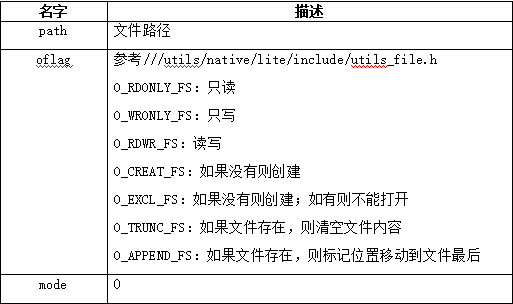基于OpenHarmony标准接口的文件读写实现案例

一、简介
在嵌入式领域,FLASH是一种常用的存储设备,Flash闪存作为嵌入式系统的主要存储设备有其自身的特性。Fash的写入操作只能把对应位置的1修改成0,而不能把0修改为1,而擦除Fash就是把对应存储块的内容恢复为1。因此,一般情况下向Fash写入内容时,需要先擦除对应的存储区间,这种擦除是以块(Bock)为单位进行的。闪存主要有NOR和NAND两种技术。因为Flash存储器的擦写次数是有限的,NAND闪存还有特殊的硬件接口和读写时序,于是就出现了专门针对FLASH的文件系统。比较常用的有jffs2,yaffs2,logfs,ubifs。本文基于小凌派-RK2206开发板 + OpenHarmony轻量级操作系统 + LitteFS文件系统,通过hal_file标准接口实现对Flash读写功能。
二、hal_file标准接口
头文件://utils/native/lite/hals/file/hal_file.h。
1、HalFileOpen()
打开/创建文件,类似于Linux的open函数。
int HalFileOpen(const char *path, int oflag, int mode);
参数说明:

返回值为LOS_OK表示成功,其余为失败。
2、HalFileClose()
关闭文件,类似于Linux的close函数。
int HalFileClose(int fd);
参数说明:

返回值为LOS_OK表示成功,其余为失败。
3、HalFileRead()
从文件中读取一段内容,类似于Linux的read函数。
int HalFileRead(int fd, char* buf, unsigned int len);
参数说明:

返回值为从文件读取内容的大小,0或者小于0则为失败。
4、HalFileWrite()
往文件写入一段内容,类似于Linux的write函数。
int HalFileWrite(int fd, const char* buf, unsigned int len);
参数说明:

返回值为成功写入到文件的内容大小,0或者小于0则为失败。
5、HalFileDelete()
删除文件,类似于Linux的unlink函数。
int HalFileDelete(const char* path);
参数说明:

返回值为LOS_OK为成功,其余则为失败。
6、HalFileStat()
获取文件大小,类似于Linux的stat函数。
int HalFileStat(const char* path, unsigned int* fileSize);
参数说明:

返回值为LOS_OK为成功,其余则为失败。
7、HalFileSeek()
文件所在位置移动,类似于Linux的lseek函数。
int HalFileSeek(int fd, int offset, unsigned int whence);
参数说明:

返回值为LOS_OK为成功,其余则为失败。
三、程序设计
本例程演示如何在小凌派-RK2206开发板上使用鸿蒙LiteOS-M内核接口,进行文件读写开发。例程流程如下所示:
(1)创建一个文件。
(2)每5秒进行1次文件读写操作。
(3)文件标识移动到文件起始处,读文件内容,并打印。
(4)文件标识移动到文件起始处,写文件内容。
(5)循环上述的第2~4步骤。
1、任务创建代码分析
在file_example函数中通过LOS_TaskCreate函数创建一个线程:hal_file_thread。
void file_example()
{
unsigned int thread_id;
TSK_INIT_PARAM_S task = {0};
unsigned int ret = LOS_OK;
task.pfnTaskEntry = (TSK_ENTRY_FUNC)hal_file_thread;
task.uwStackSize = 1024 * 10;
task.pcName = "hal_file_thread";
task.usTaskPrio = 25;
ret = LOS_TaskCreate(&thread_id, &task);
if (ret != LOS_OK)
{
printf("Falied to create hal_file_thread ret:0x%x\n", ret);
return;
}
}
APP_FEATURE_INIT(file_example);
2、文件读写代码分析
hal_file_thread函数负责打开文件,每5秒移动到文件头读取数据,再移动到文件头写入一段内容,重复以上流程。
void hal_file_thread()
{
int fd;
char buffer[1024];
int read_length, write_length;
int current = 0;
/* 打开文件,如果没有该文件就创建,如有该文件则打开
* O_TRUNC_FS => 清空文件内容
*/
//fd = HalFileOpen(FILE_NAME, O_RDWR_FS | O_CREAT_FS, 0);
fd = HalFileOpen(FILE_NAME, O_RDWR_FS | O_CREAT_FS | O_TRUNC_FS, 0);
if (fd == -1)
{
printf("%s HalFileOpen failed!\n", FILE_NAME);
return;
}
while (1)
{
/* 文件位置移动到文件开始位置 */
HalFileSeek(fd, 0, SEEK_SET);
memset(buffer, 0, sizeof(buffer));
/* 读取文件内容 */
read_length = HalFileRead(fd, buffer, sizeof(buffer));
printf("read: \n");
printf(" length = %d\n", read_length);
printf(" content = %s\n", buffer);
/* 文件位置移动到文件开始位置 */
HalFileSeek(fd, 0, SEEK_SET);
memset(buffer, 0, sizeof(buffer));
snprintf(buffer, sizeof(buffer), "Hello World(%d) => ", current);
/* 写入文件 */
write_length = HalFileWrite(fd, buffer, strlen(buffer));
current++;
LOS_Msleep(5000);
}
HalFileClose(fd);
}
四、编译过程
1、搭建和下载源代码
我已将OpenHarmony源代码上传到Gitee社区中,大家可以根据以下网址下载。
https://gitee.com/Lockzhiner-Electronics/lockzhiner-rk2206-openharmony3.0lts。
注意:编译环境可根据以下网址来操作:https://gitee.com/Lockzhiner-Electronics/lockzhiner-rk2206-openharmony3.0lts/blob/master/vendor/lockzhiner/rk2206/README_zh.md。
2、修改编译脚本
修改 vendor/lockzhiner/rk2206/sample 路径下 BUILD.gn 文件,指定 a7_hal_file 参与编译。
“./a7_hal_file:hal_file_example”,
修改 device/lockzhiner/rk2206/sdk_liteos 路径下 Makefile 文件,添加 -lhal_file_example 参与编译。
apps_LIBS = -lhal_file_example
3、编译固件
hb set -root .
hb set
hb build -f
4、烧写固件
请参考Gitee网址的说明手册(“烧录打印”章节):https://gitee.com/Lockzhiner-Electronics/lockzhiner-rk2206-openharmony3.0lts/blob/master/device/rockchip/README_zh.md。
五、实验结果
程序编译烧写到开发板后,按下开发板的RESET按键,通过串口软件查看日志如下:
HalFileInit: Flash Init Successful!
read:
length = 0
content =
read:
length = 18
content = Hello World(0) =>
read:
length = 18
content = Hello World(1) =>
好了,今天的课程就到这里,我们下次再见!
 蜀ICP备20004578号
蜀ICP备20004578号